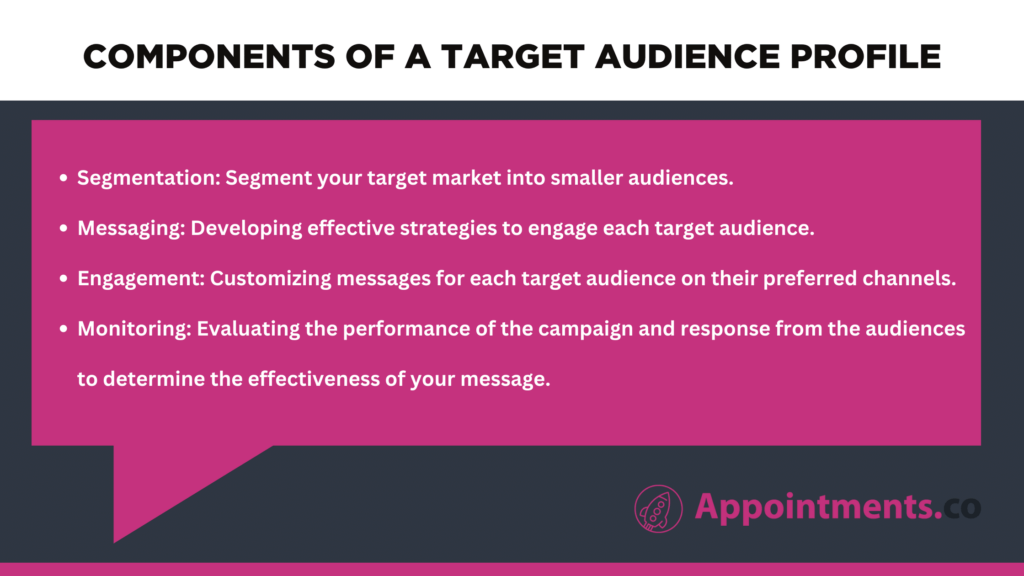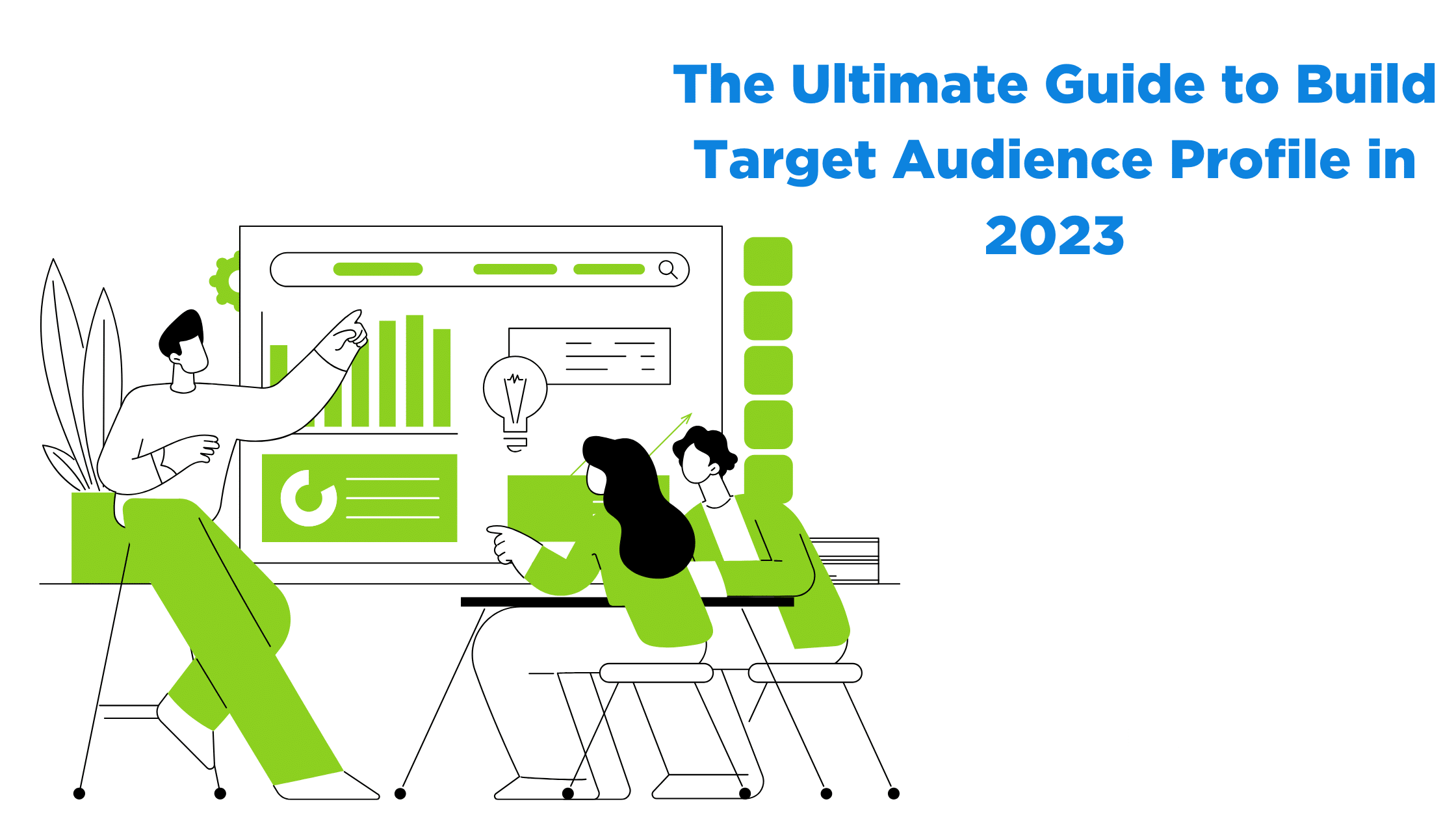The better you know someone, the easier it is to communicate and engage with them. This applies to both personal relationships and the relationship between a brand and its audience. By getting to know and understand the individuals and businesses that come in contact with your company, you can tailor your content to resonate with them.
In this article, we will explore the process of creating a target audience profile that helps you to deliver strong messages that encourage your customer to take action.
Table of contents:
- What Is a Target Audience Profile?
- How Does Target Audience Profile Help in Marketing?
- How To Create a Target Audience Profile in 6 Steps
- How To Find and Research Your Target Audience in 8 Steps
What Is a Target Audience Profile?
A target audience profile is a detailed description of your business’s ideal customers that you want to reach with your marketing. It helps you understand who you’re targeting, so you can create effective strategies and messages.
By creating audience personas, which represent your ideal customers, your marketing campaigns can be altered to attract and engage with the right people. This understanding allows you to optimize your marketing efforts and motivate your customers to take action.
To create a target audience profile, collect demographic data and characteristics that offer insights into your ideal customers. This helps you understand and engage with them effectively.
- Demographics
The basic target audience analysis focuses on demographics, which include factors, such as:
- Age
- Gender
- Education
- Income
- Profession
- Martial Status
- Interest
Besides demographics, it’s crucial to understand if your audience has common interests and preferences that can greatly influence their behavior, such as:
- Hobbies
- Favorite sports
- Reading preferences
- Movies genres
- Music genres
- Values and beliefs
- Political and social involvement
Components of a Target Audience Profile
A target audience profile is a tool to break down your target market into smaller segments for individual marketing campaigns. It consists of four key components:

- Segmentation: Segment your target market into smaller audiences.
- Messaging: Developing effective strategies to engage each target audience.
- Engagement: Customizing messages for each target audience on their preferred channels.
- Monitoring: Evaluating the performance of the campaign and response from the audiences to determine the effectiveness of your message.
How Does Target Audience Profile Help in Marketing?
Developing a target audience profile helps you create a customized marketing campaign. Not all products or services can be a solution to the pain points of individuals in your target market. For instance, let’s consider CopyPress. While some clients expect product descriptions, some are interested in eBooks. But, they all belong to your target audience, although the product descriptions are not promoted in your businesses and agencies seeking eBooks. This helps build trust with your prospective clients in the long term.
By tailoring campaigns to specific segments, you can deliver more relevant content. This personalized marketing approach increases the likelihood of higher conversion rates since you have a clearer understanding of what is appealing to your audience.
How To Create a Target Audience Profile in 6 Steps

1. Target Audience’s Data
When gathering insights about your target audience profile, quantitative data from two valuable sources can provide significant information. These sources include:
2. Google Analytics
Google Analytics simplifies audience analysis by providing valuable demographic insights about your website visitors. You can gather data on their approximate location, age, gender, interests, and device usage. Moreover, you can delve deeper into understanding how different demographics engage with specific segments of your site, target audience’s conversion rates, and the pages they visit. Additionally, Google Analytics helps you identify the channels through which specific audience segments arrived, such as social media, searches, paid advertising, or emails.
3. CRM – Customer Relationship Management
A CRM tool serves as more than just a customer management system. It acts as a dynamic repository of interactions leading to sales. The data within your CRM provides valuable insights into industries with the highest conversion rates, initial approaches of leads, and other valuable cues to attract your ideal customers. This information greatly contributes to shaping your target audience profile.
Additionally, qualitative research combines your instincts with input from your sales and marketing teams to gain deeper insights.
4. Research About Your Target Audience
After gaining an understanding of your target demographics, their location, preferred content types, and industries, it’s time to delve into their specific needs and pain points. Your CRM becomes an invaluable tool in this process, as it helps identify why your existing customers initially engaged with your brand. This information aids in pinpointing the specific challenges and concerns your target audience faces.
- What pain points were your customers trying to solve?
- What issues they encountered with other solutions they tried?
- What did your customers find useful about your product or service?
Keyword research is another valuable source of data that can provide insights into your target audience. Tools like Ahrefs, Moz, or SEMrush allow you to identify your keyword search queries for which your competitors are ranking. This data-driven approach helps you discover issues, needs, and pain points that your potential customers care about, even if they were not initially on your radar. It helps you identify relevant keywords and understand the interests and needs of your target audience.
5. Find Their Likes and Dislikes
Psychographics refers to data about a person’s interests, values, likes, dislikes, attitudes, and personality traits. It’s important to consider these factors when crafting your messaging, language, values, and imagery. They are not only crucial for branding but also for creating a target audience profile.
Developing a target audience profile helps you identify any areas where your branding may be outdated or out of touch with your audience. Don’t underestimate the importance of psychographics, as they directly impact the relevance of your content to your audience, and can affect your bottom line.
To gather psychographic data, engage in qualitative research by studying industry influencers, understanding their concerns, and examining the blogs or magazines your target demographics follow. Also, evaluate the general culture, preferences, and attitudes of your existing customers.
To support your efforts, use quantitative data from customer surveys, web analytics, Google Trends, and keyword research. These numbers provide valuable insights to enhance your understanding of your target audience.
6. Determine Frequency
The final step when creating a target audience profile is to consider the frequency of updates needed. Industries that experience rapid change or disruption may require more frequent updates as customer expectations shift with new technologies or service models.
Even in industries with slower changes, it’s important to stay mindful of evolving audience dynamics. Mindsets and preferences shift over time, influenced by the changing world. Holding onto outdated customer representations can cause your brand to appear out of touch, or lead to marketing mistakes. It is advisable to review and reevaluate your audience personas at least once a year, along with your buyer personas, to ensure their continued relevance.
How To Find and Research Your Target Audience in 8 Steps
1. Buyer Personas
Imagine your perfect customer, who would gain the most from using your product. Create a detailed customer profile that includes the demographic information, interests, and purchasing behavior of your target audience.
2. Surveys
Engage your audience directly by asking them about their interests and preferences. You can use user-friendly survey software, like SurveyMonkey, to create questionnaires that are easy to complete. Distribute these surveys to your contact lists or share them on social media platforms.
3. Google Analytics
You can use Google Analytics to gather your audience’s demographic data and their behavior online. This powerful tool provides insights into the characteristics of your website visitors and how they interact with your content.
4. Facebook and Twitter Insights
You can use analytics tools on various social media platforms to get better insights into your target audience profiles.
5. Social Monitoring
Monitor social media using tools, like Sprout and social listening platforms, to gain insights. There, you can discover what people are saying about your brand and competitors. Use this information to enhance your marketing strategies.
6. Salesforce
Analyze the preferences and characteristics of your current customers to map the buyer’s journey.
7. Feedback
Always ask for feedback from customers after their purchase of your product or service encouraging them to leave reviews and engage directly with your audience. This helps you gather valuable insights and strengthen your relationship with customers.
8. Competitors’ Social Media and Website
Analyze the website of your competitors and their social media presence.
Analyze Your Competitor’s Audience to Create an Accurate Target Audience Profile
To improve your understanding of your target audience, it’s helpful to collect the data of your competitors’ target audiences. This allows you to identify specific groups to include in your audience research and marketing plan. The benefits of this approach are as follows:
Firstly, since your competitors target the same audiences as you, you can understand the characteristics of your audience to tailor your own strategies.
Secondly, by comparing your performance to your competitors, you can identify areas where you excel and adjust your targeting tactics accordingly. This helps you refine your approach based on the analysis of your target audience.
Frequently Asked Questions
1. What are three types of audience profiles?
The three types of audience analysis are:
1. Demographic analysis
2. Psychographic analysis
3. Situational analysis
2. How do you write a target audience?
Create a target market statement that highlights the important audience characteristics you’ve discovered. Include demographic details, such as gender and age, as well as the geographic location of your target market.
3. Why is target audience profile used?
Knowing your audience is crucial for effective marketing. It’s the secret to running campaigns that actually bring in a good return on investment (ROI). Without audience profiling, you might end up wasting your efforts on people who aren’t really interested in what you have to offer. So, take the time to understand your ideal customers and create an target audience profile.
Related Reads
- How To Define an Ideal Customer Profile – 5 Easy Steps
- Best Customer Acquisition Strategies and Techniques in 2023
- Target Audience Profiling – A Quick and Easy Guide in 2023
Wrapping Up
Defining your target market is crucial to highlight the importance of the data analysis approach that focuses on the ideal type of audience of your business. The quality of the data you collect, influenced by the tools you use for audience insights, plays an important role in obtaining reliable results.
If you’re looking to expand your client base and take your business to the next level, feel free to reach out to us and learn more about how our services can support you.
Illustrations – Storyset



